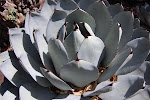Through Colorado State University and Larimer County Extension I recently participated in (and passed!) the Native Plant Master class at Lory State Park. The class was led by Dr. Tony Knight of CSU who taught us to identify about 50 native plants using the taxonomic guide Colorado Flora: Eastern Slope, 3rd Edition by William A. Weber and Ronald C. Wittmann. This was quite an experience since Weber (as this botanical bible is known) is not a picture guide but it incorporates taxonomic keys that one uses to work one's way down plant characteristics from the proper family down to the species. No pretty color pictures! Just science. We learned on the Lory State Park trails with Dr. Knight who, thankfully, would give us a common name first to visually hang onto but would then delve into the botanical characteristics and identification using a botanical key and scientific names. We reviewed ecological relationships including non-native species, noxious weeds and relationships with wildlife, pollinators.
 Species such as Golden Banner, Thermopsis divaricarpa, at left, were compared to Dalmatian Toadflax, Linaria dalmatica, below. Both are in the pea family, Fabaceae, have similar growth habits and have beautiful yellow blossoms. I've seen Golden Banner used in city gardens to good effect and of course it looks fabulous growing up hillsides in the wild. The Dalmatian Toadflax also looks beautiful in its natural setting yet Linaria dalmatica is a noxious weed in Colorado and Thermopsis divaricarpa, a wonderful native plant.
Species such as Golden Banner, Thermopsis divaricarpa, at left, were compared to Dalmatian Toadflax, Linaria dalmatica, below. Both are in the pea family, Fabaceae, have similar growth habits and have beautiful yellow blossoms. I've seen Golden Banner used in city gardens to good effect and of course it looks fabulous growing up hillsides in the wild. The Dalmatian Toadflax also looks beautiful in its natural setting yet Linaria dalmatica is a noxious weed in Colorado and Thermopsis divaricarpa, a wonderful native plant.  We got a bit of botany, lots of information, lovely green views of the park, Horsetooth Reservior and Fort Collins, and foothills hikes looking at plants with experts. For more information regarding the Native Plant program check out www.conativeplantmaster.org. More of the courses are being held at Soapstone Prairie Natural Area and up the Poudre Canyon at Young Gulch. Another bookmarkable site is www.easterncoloradowildflowers.com where the photos at right, taken by Ernie Marx, can be found. This site is an unbelieveable resource for those of us who need photos of plants to get us started on identification.
We got a bit of botany, lots of information, lovely green views of the park, Horsetooth Reservior and Fort Collins, and foothills hikes looking at plants with experts. For more information regarding the Native Plant program check out www.conativeplantmaster.org. More of the courses are being held at Soapstone Prairie Natural Area and up the Poudre Canyon at Young Gulch. Another bookmarkable site is www.easterncoloradowildflowers.com where the photos at right, taken by Ernie Marx, can be found. This site is an unbelieveable resource for those of us who need photos of plants to get us started on identification. 





